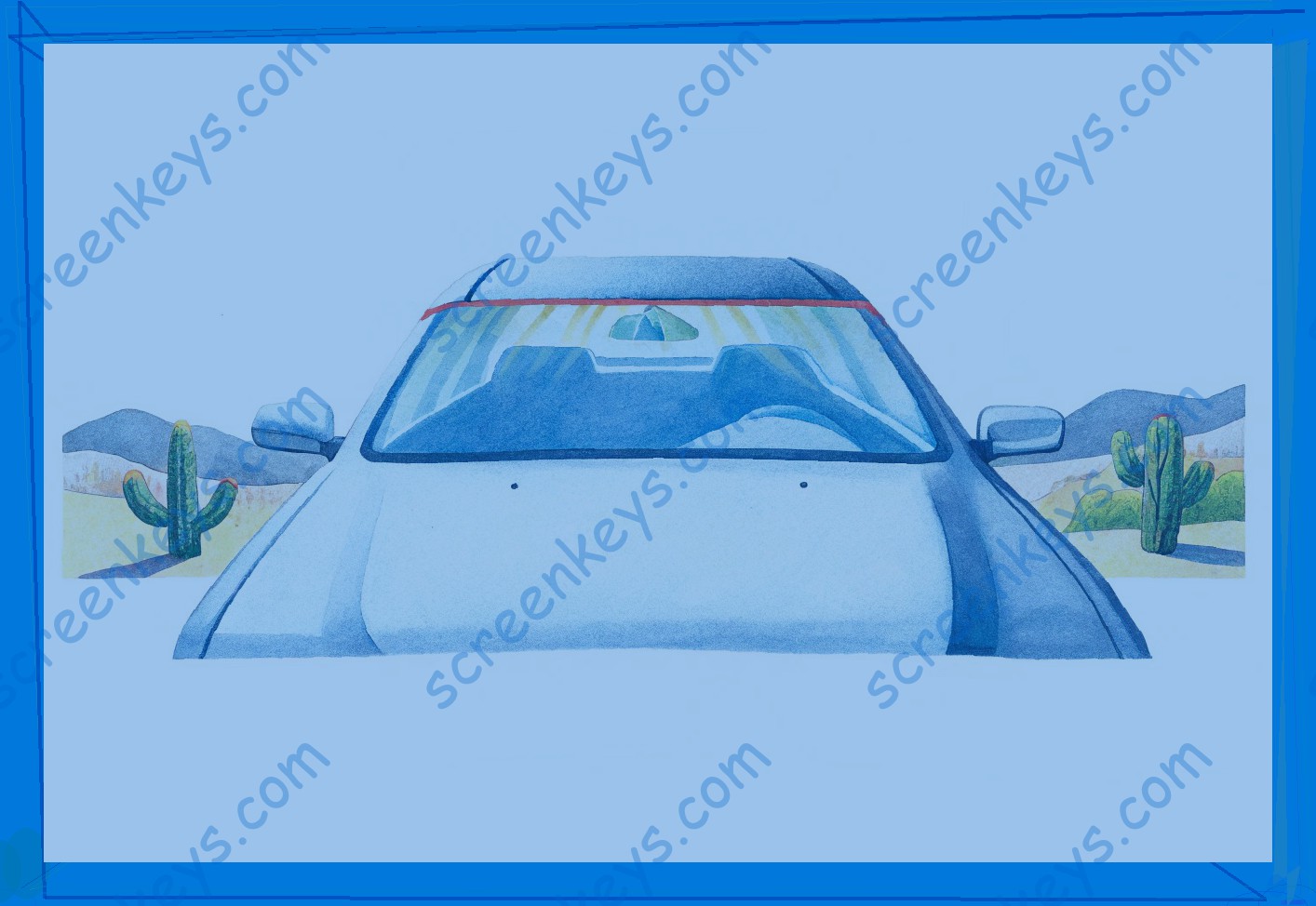An Overview of the Tint Laws in Arizona
The Arizona tint laws state "Non-reflective window film is permitted on the front windshield above the AS-1 line or the top five inches of the windshield whichever is nearer to the top of the windshield." The AS-1 line is a line found on most windshields that looks like a dot matrix at the very top. It is generally located only a few inches from the upper edge of the windshield. This AS-1 line connects the upper edge of the windshield to the mirror mount. There is no documented source to confirm precisely what the AS-1 line is, and the opinions of law enforcement officers as to its width differ. The field of vision starts one quarter inch below the AS-1 line. If your tint film extends below this line you are in violation of the law. The field of vision is 29.5 inches wide in most vehicles and 42.5 inches tall.
The side and rear windows of SUVs, vans and pickups (vehicles with a manufacturer’s listed gross vehicle weight rate of over 8 , 500 lbs.) can have any darkness window film applied.
The side and rear windows of SUVs, vans and pickups (vehicles with a manufacturer’s listed gross vehicle weight rate of 8,500 lbs. or less) shall have no more than 35% light transmittance (15% tint permitted).
The front side windows must allow more than 33% light transmittance. Vehicles already legally tinted on the front side windows need not be modified.
Any window may be covered with any reflective material that has a reflectance of 7% or less.
All window tinting must have a Certificate of Compliance issued by the manufacturer and a Certificate of Compliance issued by the installer. The vehicle owner is responsible for providing the window tinting installer with the Certificate of Compliance issued by the manufacturer. The installer shall place the certificate on the driver’s side of the vehicle.

Rationale for Legal Tint Limits in Arizona
Factors Behind the Legal Tint Limits in Arizona
Now that you know the laws, why are they there? While some rules are just a means of making revenue for the state from ticket sales, most have reasons behind them. In the case of window tinting, the regulations seek to address safety and crime concerns.
As many vehicle owners know, darker tint reduces the ability of law enforcement agencies to see those inside your vehicle. Law enforcement cannot perform their job effectively in conditions when the amount of visible light through the driver’s window is reduced, and tinted glass substantially increases safety risks (distracted driving, factors leading to accidents or rollovers, etc.).
If you bumped out your tint at 15 percent all around, that means police cannot see the full interior of your vehicle when you roll your window down during a traffic stop. If your tint is even too dark enough to see through when your window is rolled down, it opens you up to liability in the event of an accident, injury or other incident (criminal or otherwise). If contraband is found inside, it could be difficult to maintain that you had no knowledge of its presence in your vehicle.
Consequences of Exceeding Arizona’s Legal Tint Limits
The law and the Arizona Department of Safety have prescribed the consequences of exceeding legal tint limits for all windows:
First Offense: $500 fine and a requirement to remove the excess tint from the vehicle. Also, the owner’s vehicle registration and driver’s license will be placed on an "administrative hold". This means that you will not be able to sell or register any other vehicles and can not receive a new or renewal license until the tint is removed and you show proof of the removal to the Division of Motor Vehicles. One additional consequence is that the manufacturer and/or seller who installed the extra tint on your vehicle is subject to an assessment of $250 for each offense. The assessment is paid to the Department of Public Safety, and they shall remit the assessed amount to the School Safety and Safety Equipment Fund.
Second Offense: $500 fine and require the removal of the installment and replace it with a new tint complying with the requirements of this section. Also, the owner’s vehicle registration and driver’s license will continue to be on "administrative hold."
Third Offense: Same as Second Offense, but in addition, a person who receives a third or subsequent offense for having excess tint or darkness shall be guilty of a class 3 misdemeanor.
Benefits of Tinting Without Exceeding Arizona’s Legal Limits
When you choose to keep your tint within the legal limit set by Arizona law, you can continue to enjoy the benefits of tinting your vehicle windows. First and foremost, tinted windows that comply with legal limits will not impair your view while driving. In Arizona, even when legally tinted your windshield is still 70% visible light, versus only 50% of sunlight coming through the window with only a 50% tint. Tinted windows in your car can also reduce your heating and cooling costs by keeping out excess heat and maintaining the interior temperature. This benefit protects you from higher gas costs due to increased fuel consumption that can result from running your A/C during the summer months. The reduced temperature makes for a more comfortable ride, even on the hottest summer days . UV protection is an added benefit offered by window tint with legal limits. Too much sun exposure without protection can lead to skin and eye damage in the long term. Many people do not realize that regular glass windows only offer 27% protection from UV rays, while window tint offers significantly higher protection. Therefore, tinted windows in your car help safeguard the good health of your eyes in the long run. Another great benefit of window tint is that it will assist you with keeping the glass clean and free from scratches. This is important because scratched and dirty windows can create a dangerous situation on the road because they impair your vision. By keeping your windows within the legal limits set by the state, you will maximize the benefits of tinting while enjoying safe and legal use of your vehicle.
Choosing the Right Shade of Tint for Arizona Vehicles
Choosing the right tint for your vehicle involves more than simply matching the look of your neighbor’s car. Arizona law dictates what types and percentage of tint are permissible, and failing to abide by the regulations can result in receiving a ticket or failing a vehicle inspection.
One of the best rules of thumb when selecting a tint percentage is to err on the side of caution. Although the law allows 35 percent tint on windows and 50 percent on the front windshield, you want to make sure that you have the right tint in the right location.
Window tinting companies will often allow consumers to take gauges home to test the amount of tint on the window. The gauge will look somewhat like a stylus pen with a small spring-loaded suction cup at the end. When pressed firmly against glass, a small needle moves across the scale indicating the percentage of tint. Reading the percentage of tint on every window ensures that you have not made mistakes and that you comply with state regulations.
When buying a vehicle from a dealer, ask about the tint percentage on the vehicle. You may need to take it elsewhere to inspect the tint, but a reputable dealer will offer that information to you. If you buy a vehicle without tinted windows, consider taking it to the window tinting company of your choice. In fact, many state-licensed tinting company car windows for new vehicles that don’t come tinted.
If you don’t have the tools necessary to check the tint percentage, you can always consult a window tinting guide. Most of these guides are available free of charge. The information contained in the guide is relatively accurate in estimating the amount of tint on the window. This option is not one-hundred percent reliable, but it is a good fall back option before having your windows inspected by the police.
In some cases, when the tint percentage is slightly darker than the legal limit, a police officer may let it slide. In other cases, the officer will incorrectly ticket you according to their own assumptions or based on a visual comparison with their vehicle.
Stay within the limits of Arizona law by measuring tint percentages and not relying solely upon visual effects.
Arizona Tint Laws FAQ
An overview of some common questions vehicle owners may have:
Q: If I plan to use a darker tint, will my vehicle have an exemption for medical reasons?
A: The statute does provide exemptions in certain cases. Vehicle owners wishing to use window tint of a depth that is more severe than what is generally allowed by law must provide evidence of a medical need for the use of dark tints to the Department of Health Services. This can take the form of a medical opinion in writing, submitted to the Department for approval. The vehicle owner must also provide a copy of this approval to the DMV to be kept on file alongside the Certificate of Title.
Q: Are windshield tint exemptions available in Arizona?
A: The use of tint on windshields is limited technically to the top six inches of the windshield. However, this portion of tint must comply with the visible light transmission minimum of 33% to be in compliance with the law. In addition , no tint whatsoever is allowed on any other portion of the windshield. Exceptions to the rule under certain circumstances are typically issued as a result of injury, temporary illness or medication, and may be granted on a case-by-case basis. Vehicle owners wishing to use tint on windshields also require a medical certificate which must be submitted to the Department of Health Services. This certificate must then be submitted to the DMV for recordkeeping in conjunction with the Certificate of Title.
Q: Will using tinted film open up any special requirements on my end?
A: As a general rule, the only requirement that vehicle owners using tinted film must comply with is the requirement to have a Certificate of Title issued to the vehicle. This Title must be available for review by any law enforcement officer upon request when asked.



